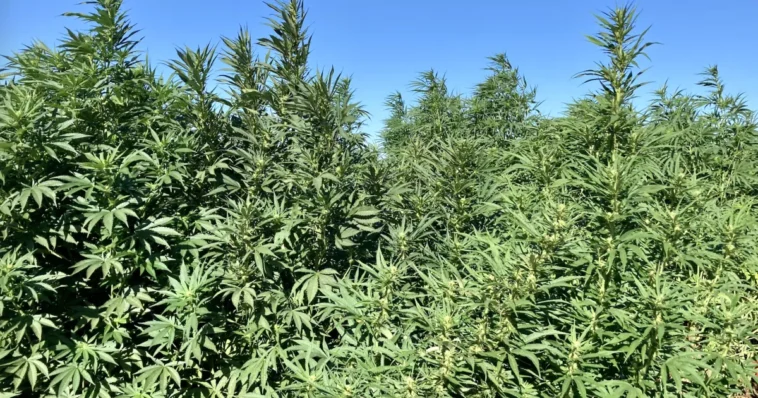By Edith Friedman, UC Berkeley
A comprehensive new report from researchers at the University of California, Berkeley, and Northeastern University reveals that cannabis cultivation in California threatens Tribal cultural resources. As in other arenas of development, however, protecting those resources faces systemic challenges.
Based on findings from a two-year study that surveyed both Tribal and agency representatives across the state, the survey found that the state’s current consultation policies, while stronger than in many other states, remain inadequate and are inconsistently applied, leading to significant risks of irreparable harm to Tribal cultural heritage sites.
“Our research shows a significant disconnect between state policy and the experience of California’s Native American Tribes. The current cannabis permitting system, while well-intentioned, fails to adequately protect ancestral lands and cultural resources,” said Jennifer Sowerwine, principal investigator on the project, and UC Cooperative Extension specialist in the Department of Environmental Science, Policy, and Management at UC Berkeley. “It’s not just about historical preservation; it’s about respecting Tribal sovereignty and ensuring that this new industry does not perpetuate old harms. These findings provide a clear roadmap for the state to move beyond performative consultation toward a process that is truly meaningful and just.”
Jeremy Sorgen, lead researcher on the project and research faculty at Northeastern University’s Oakland campus, said, “One of the first things we heard from Tribal Historic Preservation Officers and county officials plugged into cultural resource protection efforts is that cannabis cultivation often occurs on land with a high probability of being sensitive for Tribes.”
Good place to grow cannabis may be Tribal cultural resource
“If it’s relatively flat, near a source of water, and south-facing, it’s not only a good place to grow cannabis, but it may also be a ceremony or village site or other place of cultural importance to Tribes,” said Sorgen, who is also a researcher at the UC Berkeley Cannabis Research Center. “What this means is that cannabis cultivators, historically and today, are actively selecting for Tribal cultural resources.”
In 2014, California Assembly Bill 52 amended the California Environmental Quality Act, or CEQA, to include statutory requirements for Tribal cultural resource protection. This law was implemented shortly before Proposition 64 legalized adult use of cannabis in 2016. The study, “Examining Tribal Sovereignty over Cannabis Permitting on Native Ancestral Lands,” investigated the intersection of these two laws and found that AB 52, while strengthening Tribal consultation at the local level, retains many of the same problems of previous state and federal cultural resource laws.
The research was designed, conducted and analyzed in collaboration with a seven-member Tribal Advisory Committee and included comprehensive surveys of 46 Tribal representatives and 56 agency officials, alongside 61 in-depth interviews conducted across the state.
Key findings from the report include:
- Power imbalances: “Agency discretion” policies mean state and local agencies often have the last word on permit approval, CEQA exemptions, and designating Tribal cultural resources. This undermines Tribal sovereignty and exposes Tribal cultural resources to harm.
- Flawed mapping: The state’s reliance on inaccurate and contested maps results in systematic under-consultation, where the wrong Tribes are notified, culturally affiliated Tribes are excluded from the process and cultural resources go unprotected.
- Insufficient consultation: Even when consultation is triggered, the process is often treated as a procedural “box-checking” exercise rather than a meaningful, government-to-government dialogue.
- Underfunded mandate: AB 52 has resulted in an unprecedented number of project notifications, many of them likely to threaten Tribal cultural resources. Tribes lack funding for consultation-related staff, equipment and training. Agencies also lack training and resources for effective and respectful consultation.
The report offers a series of actionable recommendations for the Department of Cannabis Control and other state agencies to address these systemic issues. Key recommendations include collaborating directly with Tribal governments to develop more equitable consultation processes and accurate maps of ancestral territories. Other recommendations include initiating consultation as soon as a permit application is received, providing increased funding and specific training for Tribes and agency staff engaged in consultation, and fostering stronger data-sharing agreements between state, local and Tribal governments.
New tools support Tribal sovereignty in consultation
Building on the research findings, the research team and Tribal advisors have developed two sets of tools to support Tribal control of the consultation process.
“California has some of the strongest cultural resource protection laws in the U.S., but meaningful consultation is undermined by structural problems in the consultation process,” said Shasta Gaughen, environmental director and Tribal historic preservation officer of the Pala Band of Mission Indians and a member of the Tribal Advisory Committee. “We brought together Tribal historic preservation officers from around the state to develop a toolkit that reflects Tribal consultation experiences, is concise and easy to use, and empowers Tribes rather than agencies to set the terms of consultation.”
The By Tribes, For Tribes Consultation Policy Toolkit offers a customizable Consultation Policy Template and supplemental materials for Tribes that wish to create their own consultation policies or ordinances. The “By Tribes, For Tribes” approach enables Tribes to proactively guide government agencies through consultation processes based on Tribal priorities, rather than reacting to agency interpretations of what the law requires.
The UC Berkeley Cannabis Site Mapping Tool provides Tribes a means to assess the extent of cannabis agriculture on their ancestral or aboriginal territory. It can be used to determine possible threats to Tribal cultural resources and sensitive sites.
Both tools, the full project report, and related academic journal articles can be accessed on the Resources for Tribes webpage housed on UC Berkeley’s Cannabis Research Center website.
About the Research Team: The research was led by a collaborative team from the University of California, Berkeley, and Northeastern University, hosted at the UC Berkeley Cannabis Research Center. Team members, specializing in environmental policy, Indigenous rights, and the social impacts of cannabis legalization, include Jennifer Sowerwine,; Jeremy Sorgen; Seth LaRosa, UC Berkeley graduate student; Peter Nelson, assistant professor of environmental science, policy, and management and ethnic studies at UC Berkeley and Coast Miwok and tribal citizen of the Federated Indians of Graton Rancheria; and Van Butsic, former UC Cooperative Extension specialist at UC Berkeley.
The project was funded by the California Department of Cannabis Control and conducted in partnership with Tribal advisors and participants from across California.



GIPHY App Key not set. Please check settings